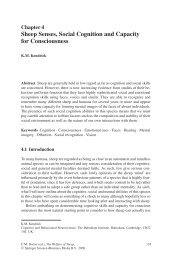Ulric Neisser
Ulric Neisser
Ulric Neisser
Create successful ePaper yourself
Turn your PDF publications into a flip-book with our unique Google optimized e-Paper software.
Cognition and Reality had several aims. One - perhaps prompted by my continued<br />
sympathy for underdogs - was simply to make Gibson's views better known. I thought people<br />
might take Cognition and Reality seriously because of the reputation I had gained with Cognitive<br />
Psychology, and that this would help the ecological enterprise. That aim may have been<br />
achieved. More ambitiously I was trying to change the direction of cognitive psychology itself,<br />
to reconcile "information pickup" and "information processing" in a new theory of perception.<br />
The central concept was the "perceptual cycle." Information is objectively available in the optic<br />
array, but picking it up requires the activity of appropriate neural structures called "schemata."<br />
The act of picking up information changes the schema, enabling it to pick up new information<br />
that in turn will change it further. This cyclic activity appears in every perceptual system,<br />
becoming more efficient with practice and expertise. To pay attention to something, for example,<br />
is simply to engage with the relevant information in an appropriate perceptual cycle. But<br />
although this way of talking still sounds plausible to me, it has had very little impact on the field.<br />
Selective looking<br />
My student Bob Becklen and I (<strong>Neisser</strong> & Becklen, 1975) illustrated this definition of<br />
attention with a phenomenon I dubbed "selective looking." When the images of two ongoing<br />
events are shown superimposed on the same screen, viewers who follow one event soon become<br />
oblivious of the other. In our study, subjects visually followed the ball-throwing of one group of<br />
players while ignoring a superimposed similar group. As they were doing this, a woman walked<br />
slowly across the scene carrying an open umbrella. One would think everyone would see such a<br />
strange intruder, but in fact very few people did (<strong>Neisser</strong>, 1979). This effect, now called<br />
"inattentional blindness," has been demonstrated repeatedly in recent years (Most et al, 2005). In<br />
a related study, Lorraine Bahrick, Arlene Walker and I (1981) were able to show that even very<br />
young infants are capable of selective looking. It is a universal aspect of attention.<br />
Another set of experiments explored the possibility of engaging in two perceptual cycles<br />
at once, i.e., of what is now called "multi-tasking." Bill Hirst and Liz Spelke (Spelke, Hirst &<br />
<strong>Neisser</strong>, 1976) modified a divided attention paradigm originally devised by Gertrude Stein<br />
(Solomons & Stein, 1896), in which subjects had to copy words at dictation while also reading<br />
stories. Their subjects practiced this every day for weeks: reading more slowly at first, they<br />
finally did reach a point where copying dictated words did not interfere with reading at all.<br />
Further studies have shown that this achievement is not (at least not always) based on rapid<br />
switching, and also that the secondary copying task does not necessarily become "automatic" (cf.<br />
Hirst et al, 1980).<br />
From perception to memory<br />
So much for Cognition and Reality, which attracted less attention than I had hoped. There<br />
is no need to mourn its passing: let us be happy that psychology has finally matured past the<br />
point where glib general theories are useful. In any case, it was time for me to move on. By the<br />
late '70's (and especially after J.J. Gibson's death in 1979), I had more or less abandoned<br />
perception for other interests. My main focus was on memory, but I was also increasingly<br />
concerned with issues of intelligence and education. My NIMH training grant in this area funded<br />
several years of stimulating "cognitive breakfasts" with students and post-docs; it also funded a<br />
1983 conference focused on the Black/White gap in school achievement. That conference was<br />
my first opportunity to discuss such issues with African-American scholars; I learned a lot from<br />
John Ogbu and Ron Edmonds and Wade Boykin. Later I put together a book based on the<br />
12




